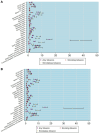Prevalence and factors associated with tobacco use among pregnant and breastfeeding mothers in India: insights from the National Family Health Survey-5 (2019-21)
- PMID: 40547460
- PMCID: PMC12180415
- DOI: 10.3389/fpubh.2025.1495522
Prevalence and factors associated with tobacco use among pregnant and breastfeeding mothers in India: insights from the National Family Health Survey-5 (2019-21)
Abstract
Background: Tobacco use remains a major public health concern, particularly in low- and middle-income countries, which account for 80% of the world's tobacco users. In India, smokeless tobacco (SLT) use is higher among women, likely due to factors such as financial dependence resulting from limited occupational opportunities, peer influence, and gender inequality. Tobacco consumption in any form poses serious health risks to both mothers and their children.
Objectives: This study aims to estimate the prevalence and factors associated with smoking tobacco and SLT among pregnant and breastfeeding mothers from the fifth National Family Health Survey (2019-21) (NFHS-5) in India.
Methods: After excluding outliers, 722,933 women of reproductive age (24,368 pregnant, 102,080 breastfeeding, and 592,699 non-pregnant/non-breastfeeding mothers) were eligible for this cross-sectional secondary data analysis. Descriptive statistics are presented as means with standard deviations (continuous variables) or frequencies (categorical variables), with a 95% confidence interval as a measure of uncertainty. The magnitude of the influence on the covariates of tobacco consumption was estimated using univariate and multivariate logistic regressions.
Results: Approximately 3.2% of mothers reported using tobacco during their current pregnancy or while breastfeeding, with a strong preference for SLT, which was over 13 times more common than smoking tobacco. Significant predictors of SLT consumption included tribal ethnicity [AOR: 2.20 (1.95-2.48)] and early motherhood [AOR: 1.12 (1.08-1.16)]. Notably, mass media awareness campaigns were ineffective in preventing SLT use among mothers [AOR: 1.49 (1.43-1.57)]. A marked difference in prevalence was observed between pregnant (2.48%) and breastfeeding (3.34%) mothers, suggesting a potential postpartum relapse. These findings underscore the potential role that Accredited Social Health Activists (ASHAs) can play during antenatal care (ANC) visits by providing consistent support for tobacco cessation.
Conclusion: Tobacco use poses serious health hazards not only to the mother but also to the developing child. Our findings indicate a lack of management and awareness, underscoring the urgent need for reforms in tobacco production and distribution to ensure improved maternal care and child health outcomes.
Keywords: India; NFHS-5; breastfeeding; pregnant women; smokeless tobacco; tobacco products; women of reproductive age.
Copyright © 2025 Pradhan, Dandsena, Singh, Ghosal, Bhattacharya, Kanungo and Pati.
Conflict of interest statement
The authors declare that the research was conducted in the absence of any commercial or financial relationships that could be construed as a potential conflict of interest. The author(s) declared that they were an editorial board member of Frontiers, at the time of submission. This had no impact on the peer review process and the final decision.
Figures


Similar articles
-
Tobacco smoking and smokeless tobacco use among people living with HIV in Zambia: Findings from a 2023 National NCD/HIV Survey.PLoS One. 2025 Jul 14;20(7):e0327130. doi: 10.1371/journal.pone.0327130. eCollection 2025. PLoS One. 2025. PMID: 40658694 Free PMC article.
-
Tobacco packaging design for reducing tobacco use.Cochrane Database Syst Rev. 2017 Apr 27;4(4):CD011244. doi: 10.1002/14651858.CD011244.pub2. Cochrane Database Syst Rev. 2017. PMID: 28447363 Free PMC article.
-
Support for healthy breastfeeding mothers with healthy term babies.Cochrane Database Syst Rev. 2022 Oct 25;10(10):CD001141. doi: 10.1002/14651858.CD001141.pub6. Cochrane Database Syst Rev. 2022. PMID: 36282618 Free PMC article.
-
Antiretrovirals for reducing the risk of mother-to-child transmission of HIV infection.Cochrane Database Syst Rev. 2007 Jan 24;(1):CD003510. doi: 10.1002/14651858.CD003510.pub2. Cochrane Database Syst Rev. 2007. Update in: Cochrane Database Syst Rev. 2011 Jul 06;(7):CD003510. doi: 10.1002/14651858.CD003510.pub3. PMID: 17253490 Updated.
-
Prevalence and correlates of contraceptive use among adolescent mothers: Results from a cross-sectional survey in Ouagadougou, Burkina Faso, and Blantyre, Malawi.PLoS One. 2025 Jun 18;20(6):e0319136. doi: 10.1371/journal.pone.0319136. eCollection 2025. PLoS One. 2025. PMID: 40531984 Free PMC article.
References
-
- Gately I. Tobacco—a cultural history of how an exotic plant seduced civilization. 416 p. Available online at: https://www.google.co.in/books/edition/Tobacco/x41jVocj05EC?hl=en&gbpv=1...
MeSH terms
LinkOut - more resources
Full Text Sources
Medical

